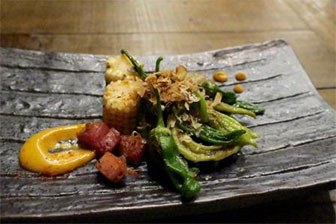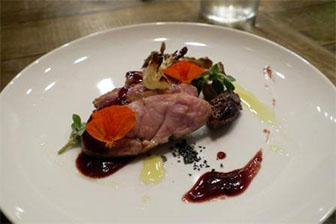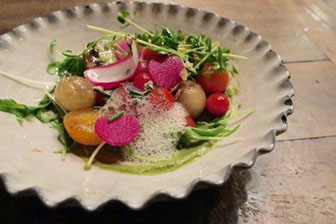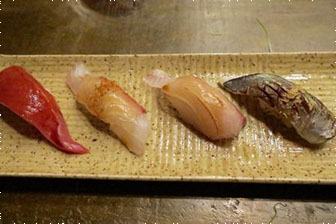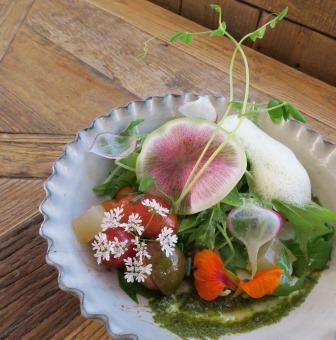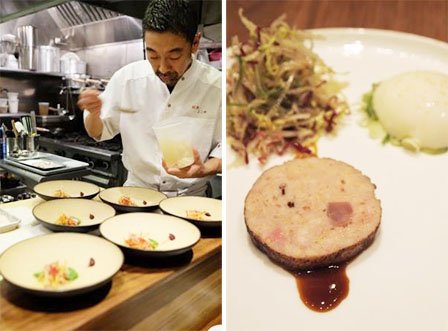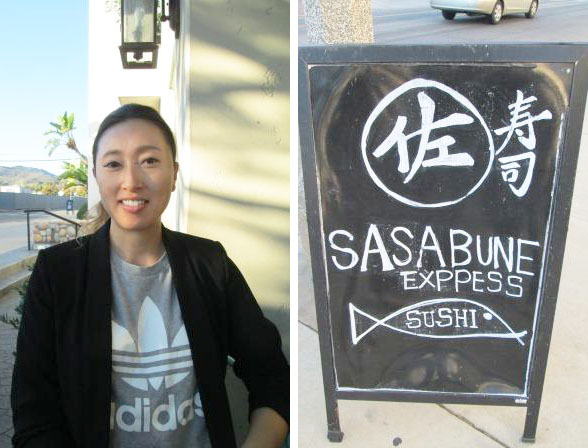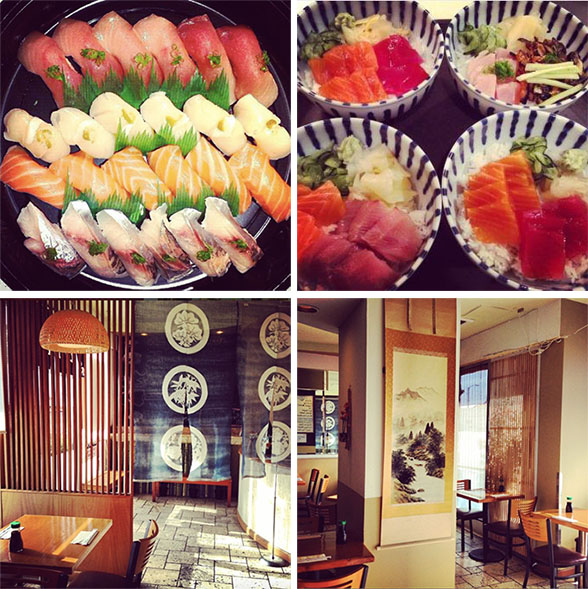Delage
Kappo Omakase-style California fusion restaurant
By Elli Sekine
In the past few years, the food culture of the Auckland area has been changing dramatically. Along with the rising popularity of the farmer’s market in Jack London Square, the awareness of local production for local consumption is growing, and the chefs from “Chez Panisse” in the neighbor town, Berkeley, where California cuisine was born, started to open restaurants in Auckland one after another. People in the area now talk about gourmet foods all the time, and such a food-business-friendly environment has made young food business entrepreneurs very diverse in their businesses from casual and unique eateries, to food trucks and catering. You can catch a glimpse of the trend in the food culture everywhere in town. The market/food court, “SWAN” was renewed 4 years ago, and became a casual dining food court where some well-known chefs participated in serving their food there, which gathered much attention. It has become one of Auckland’s hot spots nowadays. “Delage” in SWAN is the second restaurant of “AS B-Dama” which has been there since the opening. Although it still has tenant status in the food court, “Delage” opened as an individual restaurant in April of 2016, and is gaining popularity as a casual omakase style restaurant.
The concept by the owner/chef Tsutomu Ono, “Quality & Casual”, has finely seized the local fans. After gaining the experience of working as a chef in the South Bay area for a long time in a Japanese restaurant, Mr. Ono launched a small place for bento and a-la-carte dishes in Auckland called “Geta”.
Later, he achieved success with a bento dine-in place called “B-Dama”, which led to becoming a tenant in “SWAN”, and changed the name to “AS B-Dama”.
Supported by passionate local fans, “Delage” was opened within the same property as an individual restaurant this time. It is the first omakase-style Japanese restaurant run by Japanese in Auckland. The opening of this restaurant which aims for “high-end with the casual ambience of Auckland” attracted a lot of attention with the attendance of Masaki Sasaki who has led two restaurants to their Michelin-star ranks. Moreover, the reasonable pricing at $65 for an upscale 8-course meal cannot be seen anywhere else.
The wood-based interior feels warm and relaxed, and the displayed old vinyl records, cassette tape players, etc. creates a nostalgic ambience. Including some which are rare finds among collectors, a hand-crafted warm feeling in an independent restaurant is presented.
The menu is unique with added Californian and French techniques. The dishes for the day started and continued with California style organic cherry tomato salad, Miyazaki wagyu beef on a salt block, smoked salmon, omakase nigiri-sushi, chilled cauliflower soup, and warm vegetables with sesame-ponzu sauce. The presentation of Californian kappo with the combination of vegetables, duck, other meat, and sushi on the stylish ceramic ware evokes excitement. The concept of local production for local consumption is enforced by the way they buy the food ingredients, from the fish and farmer’s markets by the owner himself as well as for “AS B-Dama”.
“Delage” is now in its second phase. Kaoru Ishii, the sushi chef, and Mikiko Ando, the kitchen chef have succeeded Mr. Sasaki, the opening chef. Mr. Ishii is a veteran chef with 42-years of experience. He has worked in an Italian restaurant, and a robata grill restaurant in Japan, “Matsuhisa” in LA, and “Sushi Ran” in Sausalito. Ms. Ando has worked in San Francisco area restaurants as a sushi chef at “Sushi Chardonnay”, “Yuzu”, and “Delica”. She passionately said that she would love to keep offering a creative menu using a lot of local vegetables.
As for the drink menu, they offer a wide variety of beer, wine, and sake. There is an extensive list of Japanese local sake brands, which makes for a popular paring with the food. For the beer selection, in addition to some brands, a draft beer is poured from installed barrels imported from Japan. In the summer time, you can enjoy drinks in the outdoor garden setting.
Compared to San Francisco, there are fewer Michelin class high-end restaurants in Auckland. However, casual gourmet style is settled in, and people in the East Bay are very picky in taste and value consciousness. “Delage” is well liked in such an environment as a restaurant where people can experience high-end Japanese cuisine in a casual manner.
カリフォルニアを融合した割烹オマカセ
ここ数年、オークランドの外食シーンが大きく変化している。Jack London Squareのファーマーズマーケットの人気と共に地産地消の意識が広がり、“リアルフード”を求める人口が増えている。さらに隣町、バークレーのカリフォルニア料理発祥の店、「シェ・パニーズ」出身のシェフ達が続々オークランドに店舗を持ち始め、グルメの話題が尽きない。また、食ビジネスが起業しやすい市による環境作りで、若い食起業家によるカジュアルで個性的な店やフードトラック、ケータリングなどビジネスも多様化し、街の至る所で食のトレンドを垣間見る事ができる。4年前、リニューアルされた食マーケット&フードコート「SWAN」は、有名シェフも参加するB級グルメのフードコートで話題を呼び、今ではオークランドのホットスポットになっている。「Delage」は、同テナントとしてオープニングから出店していた「AS B-Dama」に続く第2号店となる。2016年4月の開店以来、カジュアルなオマカセ店として人気を集めている。
オーナーシェフの小野力氏が持つコンセプト、“クオリティ&カッジュアル”は見事に地元のファンを掴んだ。同氏は、長年サウスベイで日本食レストランにシェフとして勤めた後、オークランドで小さな惣菜と弁当の「Geta」を起業、 その後、弁当を中心としたイートイン、「B−Dama 」の成功で、「SWAN」にテナントとし移動し、「As B-Dama 」に改名。今回、地元の熱い声援に応え、同じ敷地内、独立店舗として「Delage」のオープンに至った。オークランドで日本人経営者によるオマカセ専門店は初めて。「オークランドの気さくな雰囲気を取り入れたハイエンド」を目指した同店の立ち上げには、2軒のレストランをミシュラン星に導いた佐々木正樹氏が加わり話題を集めた。しかも、グレードアップした8コースが$65と他店では見られない良心的な料金設定だ。
内装は、木材を使った暖かく落ち着いた内装で、古いレコードやカセットテープ、音楽プレーヤーなどをディスプレイし、ノスタルジックなムードを演出している。中にはマニアの中で貴重なアイテムもあり、独立店舗として手作り感が伝わる暖かさが表現されている。
メニューはカリフォルニアとフレンチ技術が加わった独特のスタイル。その日のメニューは、カリフォルニア風オーガニックのチェリートマトサラダ、塩ブロックの上に盛り付けた宮崎ビーフと軽く燻製されたサーモン、オマカセ握り寿司、カリフラワー冷静スープ、温野菜の胡麻ポン酢和えと続く。このように野菜、鴨、肉、魚、野菜、寿司を組み合わせたカリフォルニア風割烹とデザインされた陶器とのプレゼンテーションはワクワクする内容だ。食材は「AS B−Dama」と同様、魚市場やファーマーズマーケットにオーナー自ら出向くなど極力地産地消を心がけている。
「Delage」は、現在2期目を迎えている。オープニングシェフの佐々木氏からバトンを受け取ったのは、寿司シェフの石井薫氏とキッチンシェフの安藤美樹子氏だ。石井氏はシェフ歴42年のベテランで、日本ではイタリアンや炉端店、米国では、Los Angeles の「Matsuhisa」, Sausalitoの「Sushi Ran」 でシェフを務めた。
一方、安藤氏は、サンフランシスコ地区で「Sushi Chardonnay」、「Yuzu」、「Delica」 での寿司シェフを勤めている。安藤氏は、「地元の野菜をたっぷり使った創造的なメニューを作りたい」と意気込んでいた。
ドリンクメニューはビール、ワイン、酒など多種を取り揃える。中でも日本酒は地方からの名酒がラインアップし、日本酒とのペアリングも人気だ。また、ビールは各メーカー他、日本輸入の樽から注ぐ生ビールを設置し、夏季には屋外ガーデンでドリンクも楽しめる。
オークランドのレストランは、サンフランシスコと比較すると高級店は少ないが、カジュアルグルメが浸透しており、イーストベイの客は味にうるさくとバリューに敏感だ。 そんな中「Delage」は、ハイエンドな日本食が気軽に体験できるレストランとして地域に愛されてる。
Delage
536 9th St.
Oakland, CA 94607
(510) 823-2050
http://www.delageoakland.com/
Tues.-Thurs./ 5:30pm-9:30pm
By Elli Sekine
In the past few years, the food culture of the Auckland area has been changing dramatically. Along with the rising popularity of the farmer’s market in Jack London Square, the awareness of local production for local consumption is growing, and the chefs from “Chez Panisse” in the neighbor town, Berkeley, where California cuisine was born, started to open restaurants in Auckland one after another. People in the area now talk about gourmet foods all the time, and such a food-business-friendly environment has made young food business entrepreneurs very diverse in their businesses from casual and unique eateries, to food trucks and catering. You can catch a glimpse of the trend in the food culture everywhere in town. The market/food court, “SWAN” was renewed 4 years ago, and became a casual dining food court where some well-known chefs participated in serving their food there, which gathered much attention. It has become one of Auckland’s hot spots nowadays. “Delage” in SWAN is the second restaurant of “AS B-Dama” which has been there since the opening. Although it still has tenant status in the food court, “Delage” opened as an individual restaurant in April of 2016, and is gaining popularity as a casual omakase style restaurant.
The concept by the owner/chef Tsutomu Ono, “Quality & Casual”, has finely seized the local fans. After gaining the experience of working as a chef in the South Bay area for a long time in a Japanese restaurant, Mr. Ono launched a small place for bento and a-la-carte dishes in Auckland called “Geta”.
Later, he achieved success with a bento dine-in place called “B-Dama”, which led to becoming a tenant in “SWAN”, and changed the name to “AS B-Dama”.
Supported by passionate local fans, “Delage” was opened within the same property as an individual restaurant this time. It is the first omakase-style Japanese restaurant run by Japanese in Auckland. The opening of this restaurant which aims for “high-end with the casual ambience of Auckland” attracted a lot of attention with the attendance of Masaki Sasaki who has led two restaurants to their Michelin-star ranks. Moreover, the reasonable pricing at $65 for an upscale 8-course meal cannot be seen anywhere else.
The wood-based interior feels warm and relaxed, and the displayed old vinyl records, cassette tape players, etc. creates a nostalgic ambience. Including some which are rare finds among collectors, a hand-crafted warm feeling in an independent restaurant is presented.
The menu is unique with added Californian and French techniques. The dishes for the day started and continued with California style organic cherry tomato salad, Miyazaki wagyu beef on a salt block, smoked salmon, omakase nigiri-sushi, chilled cauliflower soup, and warm vegetables with sesame-ponzu sauce. The presentation of Californian kappo with the combination of vegetables, duck, other meat, and sushi on the stylish ceramic ware evokes excitement. The concept of local production for local consumption is enforced by the way they buy the food ingredients, from the fish and farmer’s markets by the owner himself as well as for “AS B-Dama”.
“Delage” is now in its second phase. Kaoru Ishii, the sushi chef, and Mikiko Ando, the kitchen chef have succeeded Mr. Sasaki, the opening chef. Mr. Ishii is a veteran chef with 42-years of experience. He has worked in an Italian restaurant, and a robata grill restaurant in Japan, “Matsuhisa” in LA, and “Sushi Ran” in Sausalito. Ms. Ando has worked in San Francisco area restaurants as a sushi chef at “Sushi Chardonnay”, “Yuzu”, and “Delica”. She passionately said that she would love to keep offering a creative menu using a lot of local vegetables.
As for the drink menu, they offer a wide variety of beer, wine, and sake. There is an extensive list of Japanese local sake brands, which makes for a popular paring with the food. For the beer selection, in addition to some brands, a draft beer is poured from installed barrels imported from Japan. In the summer time, you can enjoy drinks in the outdoor garden setting.
Compared to San Francisco, there are fewer Michelin class high-end restaurants in Auckland. However, casual gourmet style is settled in, and people in the East Bay are very picky in taste and value consciousness. “Delage” is well liked in such an environment as a restaurant where people can experience high-end Japanese cuisine in a casual manner.
カリフォルニアを融合した割烹オマカセ
ここ数年、オークランドの外食シーンが大きく変化している。Jack London Squareのファーマーズマーケットの人気と共に地産地消の意識が広がり、“リアルフード”を求める人口が増えている。さらに隣町、バークレーのカリフォルニア料理発祥の店、「シェ・パニーズ」出身のシェフ達が続々オークランドに店舗を持ち始め、グルメの話題が尽きない。また、食ビジネスが起業しやすい市による環境作りで、若い食起業家によるカジュアルで個性的な店やフードトラック、ケータリングなどビジネスも多様化し、街の至る所で食のトレンドを垣間見る事ができる。4年前、リニューアルされた食マーケット&フードコート「SWAN」は、有名シェフも参加するB級グルメのフードコートで話題を呼び、今ではオークランドのホットスポットになっている。「Delage」は、同テナントとしてオープニングから出店していた「AS B-Dama」に続く第2号店となる。2016年4月の開店以来、カジュアルなオマカセ店として人気を集めている。
オーナーシェフの小野力氏が持つコンセプト、“クオリティ&カッジュアル”は見事に地元のファンを掴んだ。同氏は、長年サウスベイで日本食レストランにシェフとして勤めた後、オークランドで小さな惣菜と弁当の「Geta」を起業、 その後、弁当を中心としたイートイン、「B−Dama 」の成功で、「SWAN」にテナントとし移動し、「As B-Dama 」に改名。今回、地元の熱い声援に応え、同じ敷地内、独立店舗として「Delage」のオープンに至った。オークランドで日本人経営者によるオマカセ専門店は初めて。「オークランドの気さくな雰囲気を取り入れたハイエンド」を目指した同店の立ち上げには、2軒のレストランをミシュラン星に導いた佐々木正樹氏が加わり話題を集めた。しかも、グレードアップした8コースが$65と他店では見られない良心的な料金設定だ。
内装は、木材を使った暖かく落ち着いた内装で、古いレコードやカセットテープ、音楽プレーヤーなどをディスプレイし、ノスタルジックなムードを演出している。中にはマニアの中で貴重なアイテムもあり、独立店舗として手作り感が伝わる暖かさが表現されている。
メニューはカリフォルニアとフレンチ技術が加わった独特のスタイル。その日のメニューは、カリフォルニア風オーガニックのチェリートマトサラダ、塩ブロックの上に盛り付けた宮崎ビーフと軽く燻製されたサーモン、オマカセ握り寿司、カリフラワー冷静スープ、温野菜の胡麻ポン酢和えと続く。このように野菜、鴨、肉、魚、野菜、寿司を組み合わせたカリフォルニア風割烹とデザインされた陶器とのプレゼンテーションはワクワクする内容だ。食材は「AS B−Dama」と同様、魚市場やファーマーズマーケットにオーナー自ら出向くなど極力地産地消を心がけている。
「Delage」は、現在2期目を迎えている。オープニングシェフの佐々木氏からバトンを受け取ったのは、寿司シェフの石井薫氏とキッチンシェフの安藤美樹子氏だ。石井氏はシェフ歴42年のベテランで、日本ではイタリアンや炉端店、米国では、Los Angeles の「Matsuhisa」, Sausalitoの「Sushi Ran」 でシェフを務めた。
一方、安藤氏は、サンフランシスコ地区で「Sushi Chardonnay」、「Yuzu」、「Delica」 での寿司シェフを勤めている。安藤氏は、「地元の野菜をたっぷり使った創造的なメニューを作りたい」と意気込んでいた。
ドリンクメニューはビール、ワイン、酒など多種を取り揃える。中でも日本酒は地方からの名酒がラインアップし、日本酒とのペアリングも人気だ。また、ビールは各メーカー他、日本輸入の樽から注ぐ生ビールを設置し、夏季には屋外ガーデンでドリンクも楽しめる。
オークランドのレストランは、サンフランシスコと比較すると高級店は少ないが、カジュアルグルメが浸透しており、イーストベイの客は味にうるさくとバリューに敏感だ。 そんな中「Delage」は、ハイエンドな日本食が気軽に体験できるレストランとして地域に愛されてる。
Delage
536 9th St.
Oakland, CA 94607
(510) 823-2050
http://www.delageoakland.com/
Tues.-Thurs./ 5:30pm-9:30pm







